Baochun Li
Leaner Training, Lower Leakage: Revisiting Memorization in LLM Fine-Tuning with LoRA
Jun 25, 2025Abstract:Memorization in large language models (LLMs) makes them vulnerable to data extraction attacks. While pre-training memorization has been extensively studied, fewer works have explored its impact in fine-tuning, particularly for LoRA fine-tuning, a widely adopted parameter-efficient method. In this work, we re-examine memorization in fine-tuning and uncover a surprising divergence from prior findings across different fine-tuning strategies. Factors such as model scale and data duplication, which strongly influence memorization in pre-training and full fine-tuning, do not follow the same trend in LoRA fine-tuning. Using a more relaxed similarity-based memorization metric, we demonstrate that LoRA significantly reduces memorization risks compared to full fine-tuning, while still maintaining strong task performance.
Hear No Evil: Detecting Gradient Leakage by Malicious Servers in Federated Learning
Jun 25, 2025Abstract:Recent work has shown that gradient updates in federated learning (FL) can unintentionally reveal sensitive information about a client's local data. This risk becomes significantly greater when a malicious server manipulates the global model to provoke information-rich updates from clients. In this paper, we adopt a defender's perspective to provide the first comprehensive analysis of malicious gradient leakage attacks and the model manipulation techniques that enable them. Our investigation reveals a core trade-off: these attacks cannot be both highly effective in reconstructing private data and sufficiently stealthy to evade detection -- especially in realistic FL settings that incorporate common normalization techniques and federated averaging. Building on this insight, we argue that malicious gradient leakage attacks, while theoretically concerning, are inherently limited in practice and often detectable through basic monitoring. As a complementary contribution, we propose a simple, lightweight, and broadly applicable client-side detection mechanism that flags suspicious model updates before local training begins, despite the fact that such detection may not be strictly necessary in realistic FL settings. This mechanism further underscores the feasibility of defending against these attacks with minimal overhead, offering a deployable safeguard for privacy-conscious federated learning systems.
TreeX: Generating Global Graphical GNN Explanations via Critical Subtree Extraction
Mar 12, 2025Abstract:The growing demand for transparency and interpretability in critical domains has driven increased interests in comprehending the explainability of Message-Passing (MP) Graph Neural Networks (GNNs). Although substantial research efforts have been made to generate explanations for individual graph instances, identifying global explaining concepts for a GNN still poses great challenges, especially when concepts are desired in a graphical form on the dataset level. While most prior works treat GNNs as black boxes, in this paper, we propose to unbox GNNs by analyzing and extracting critical subtrees incurred by the inner workings of message passing, which correspond to critical subgraphs in the datasets. By aggregating subtrees in an embedding space with an efficient algorithm, which does not require complex subgraph matching or search, we can make intuitive graphical explanations for Message-Passing GNNs on local, class and global levels. We empirically show that our proposed approach not only generates clean subgraph concepts on a dataset level in contrast to existing global explaining methods which generate non-graphical rules (e.g., language or embeddings) as explanations, but it is also capable of providing explanations for individual instances with a comparable or even superior performance as compared to leading local-level GNN explainers.
Calibre: Towards Fair and Accurate Personalized Federated Learning with Self-Supervised Learning
Dec 28, 2024



Abstract:In the context of personalized federated learning, existing approaches train a global model to extract transferable representations, based on which any client could train personalized models with a limited number of data samples. Self-supervised learning is considered a promising direction as the global model it produces is generic and facilitates personalization for all clients fairly. However, when data is heterogeneous across clients, the global model trained using SSL is unable to learn high-quality personalized models. In this paper, we show that when the global model is trained with SSL without modifications, its produced representations have fuzzy class boundaries. As a result, personalized learning within each client produces models with low accuracy. In order to improve SSL towards better accuracy without sacrificing its advantage in fairness, we propose Calibre, a new personalized federated learning framework designed to calibrate SSL representations by maintaining a suitable balance between more generic and more client-specific representations. Calibre is designed based on theoretically-sound properties, and introduces (1) a client-specific prototype loss as an auxiliary training objective; and (2) an aggregation algorithm guided by such prototypes across clients. Our experimental results in an extensive array of non-i.i.d.~settings show that Calibre achieves state-of-the-art performance in terms of both mean accuracy and fairness across clients. Code repo: https://github.com/TL-System/plato/tree/main/examples/ssl/calibre.
Toward Adaptive Reasoning in Large Language Models with Thought Rollback
Dec 27, 2024


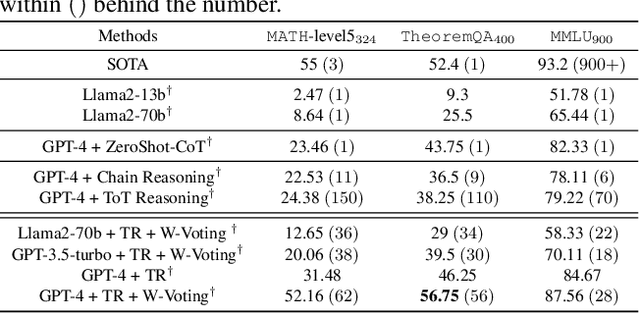
Abstract:Large language models (LLMs) have been routinely used to solve various tasks using step-by-step reasoning. However, the structure of intermediate reasoning steps, or thoughts, is rigid and unidirectional, such as chains, trees, or acyclic-directed graphs. Consequently, the resulting inflexible and forward-only reasoning may not address challenging tasks and fail when the LLM frequently gives false responses, i.e., ``hallucinations''. This paper proposes a new reasoning framework, called Thought Rollback (TR), allowing LLMs to adaptively build thought structure while maintaining effective reasoning toward problem-solving under ``hallucinations''. The core mechanism of TR is rolling back thoughts, which allows LLMs to perform error analysis on thoughts, and thus roll back to any previously mistaken thought for revision. Subsequently, by including such trial-and-error in the prompt to guide the LLM, each rollback leads to one more reliable reasoning path. Therefore, starting with a simple prompt without human annotations, LLM with TR adaptively and gradually explores thoughts for a correct solution. Comprehensive experiments on mathematical problems and multi-task reasoning demonstrate the state-of-the-art performance of TR in terms of problem-solving rate and interaction cost. For instance, the solving rate of GPT-4 with TR outperforms the current best by $9\%$ on the MATH dataset.
Hufu: A Modality-Agnositc Watermarking System for Pre-Trained Transformers via Permutation Equivariance
Mar 09, 2024



Abstract:With the blossom of deep learning models and services, it has become an imperative concern to safeguard the valuable model parameters from being stolen. Watermarking is considered an important tool for ownership verification. However, current watermarking schemes are customized for different models and tasks, hard to be integrated as an integrated intellectual protection service. We propose Hufu, a modality-agnostic watermarking system for pre-trained Transformer-based models, relying on the permutation equivariance property of Transformers. Hufu embeds watermark by fine-tuning the pre-trained model on a set of data samples specifically permuted, and the embedded model essentially contains two sets of weights -- one for normal use and the other for watermark extraction which is triggered on permuted inputs. The permutation equivariance ensures minimal interference between these two sets of model weights and thus high fidelity on downstream tasks. Since our method only depends on the model itself, it is naturally modality-agnostic, task-independent, and trigger-sample-free. Extensive experiments on the state-of-the-art vision Transformers, BERT, and GPT2 have demonstrated Hufu's superiority in meeting watermarking requirements including effectiveness, efficiency, fidelity, and robustness, showing its great potential to be deployed as a uniform ownership verification service for various Transformers.
FedReview: A Review Mechanism for Rejecting Poisoned Updates in Federated Learning
Feb 26, 2024



Abstract:Federated learning has recently emerged as a decentralized approach to learn a high-performance model without access to user data. Despite its effectiveness, federated learning gives malicious users opportunities to manipulate the model by uploading poisoned model updates to the server. In this paper, we propose a review mechanism called FedReview to identify and decline the potential poisoned updates in federated learning. Under our mechanism, the server randomly assigns a subset of clients as reviewers to evaluate the model updates on their training datasets in each round. The reviewers rank the model updates based on the evaluation results and count the number of the updates with relatively low quality as the estimated number of poisoned updates. Based on review reports, the server employs a majority voting mechanism to integrate the rankings and remove the potential poisoned updates in the model aggregation process. Extensive evaluation on multiple datasets demonstrate that FedReview can assist the server to learn a well-performed global model in an adversarial environment.
Boosting of Thoughts: Trial-and-Error Problem Solving with Large Language Models
Feb 17, 2024



Abstract:The reasoning performance of Large Language Models (LLMs) on a wide range of problems critically relies on chain-of-thought prompting, which involves providing a few chain of thought demonstrations as exemplars in prompts. Recent work, e.g., Tree of Thoughts, has pointed out the importance of exploration and self-evaluation in reasoning step selection for complex problem solving. In this paper, we present Boosting of Thoughts (BoT), an automated prompting framework for problem solving with LLMs by iteratively exploring and self-evaluating many trees of thoughts in order to acquire an ensemble of trial-and-error reasoning experiences, which will serve as a new form of prompting to solve the complex problem. Starting from a simple prompt without requiring examples, BoT iteratively explores and evaluates a large collection of reasoning steps, and more importantly, uses error analysis obtained from the LLM on them to explicitly revise prompting, which in turn enhances reasoning step generation, until a final answer is attained. Our experiments with GPT-4 and Llama2 across extensive complex mathematical problems demonstrate that BoT consistently achieves higher or comparable problem-solving rates than other advanced prompting approaches.
Language-Guided Diffusion Model for Visual Grounding
Aug 18, 2023



Abstract:Visual grounding (VG) tasks involve explicit cross-modal alignment, as semantically corresponding image regions are to be located for the language phrases provided. Existing approaches complete such visual-text reasoning in a single-step manner. Their performance causes high demands on large-scale anchors and over-designed multi-modal fusion modules based on human priors, leading to complicated frameworks that may be difficult to train and overfit to specific scenarios. Even worse, such once-for-all reasoning mechanisms are incapable of refining boxes continuously to enhance query-region matching. In contrast, in this paper, we formulate an iterative reasoning process by denoising diffusion modeling. Specifically, we propose a language-guided diffusion framework for visual grounding, LG-DVG, which trains the model to progressively reason queried object boxes by denoising a set of noisy boxes with the language guide. To achieve this, LG-DVG gradually perturbs query-aligned ground truth boxes to noisy ones and reverses this process step by step, conditional on query semantics. Extensive experiments for our proposed framework on five widely used datasets validate the superior performance of solving visual grounding, a cross-modal alignment task, in a generative way. The source codes are available at \url{https://github.com/iQua/vgbase/tree/DiffusionVG}.
Feature Reconstruction Attacks and Countermeasures of DNN training in Vertical Federated Learning
Oct 13, 2022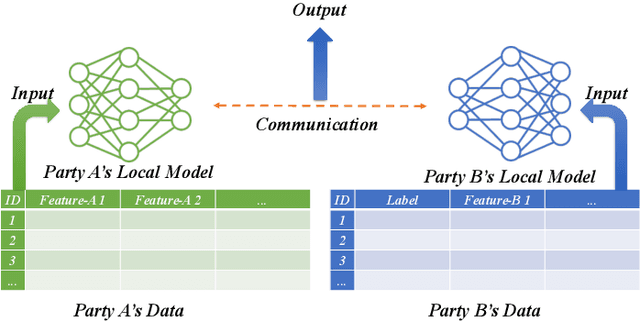
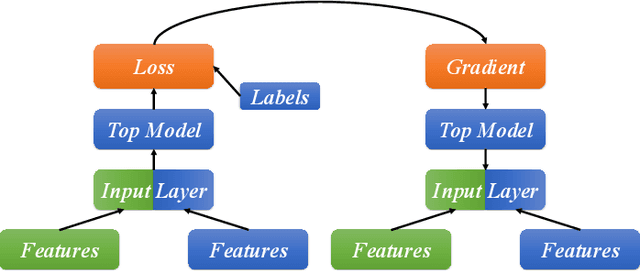
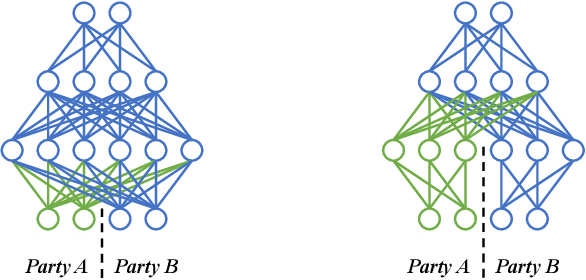
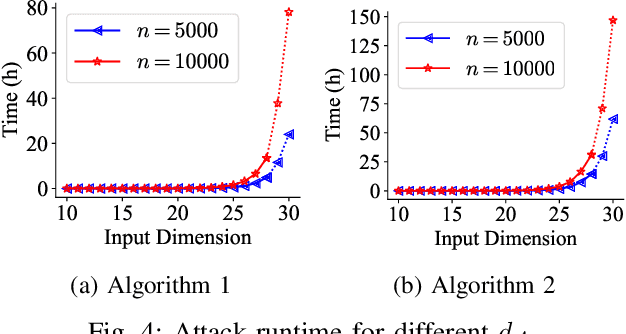
Abstract:Federated learning (FL) has increasingly been deployed, in its vertical form, among organizations to facilitate secure collaborative training over siloed data. In vertical FL (VFL), participants hold disjoint features of the same set of sample instances. Among them, only one has labels. This participant, known as the active party, initiates the training and interacts with the other participants, known as the passive parties. Despite the increasing adoption of VFL, it remains largely unknown if and how the active party can extract feature data from the passive party, especially when training deep neural network (DNN) models. This paper makes the first attempt to study the feature security problem of DNN training in VFL. We consider a DNN model partitioned between active and passive parties, where the latter only holds a subset of the input layer and exhibits some categorical features of binary values. Using a reduction from the Exact Cover problem, we prove that reconstructing those binary features is NP-hard. Through analysis, we demonstrate that, unless the feature dimension is exceedingly large, it remains feasible, both theoretically and practically, to launch a reconstruction attack with an efficient search-based algorithm that prevails over current feature protection techniques. To address this problem, we develop a novel feature protection scheme against the reconstruction attack that effectively misleads the search to some pre-specified random values. With an extensive set of experiments, we show that our protection scheme sustains the feature reconstruction attack in various VFL applications at no expense of accuracy loss.
 Add to Chrome
Add to Chrome Add to Firefox
Add to Firefox Add to Edge
Add to Edge